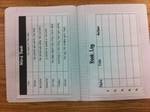Do you use reader's response journals in your room? I just love how wonderful these work in my room and the kids seem to LOVE THEM! We use them at least once a day but usually more since they are using them during guided reading and centers. Students also know that when they are completed with their work, they are to get out a book. They are not required to do a reading response journal page at this time but they often CHOOSE to. WOW!!!
The Journal
The first day:
Day one of using the journals is an exciting day for the kids. The teacher will talk with the students about being in a book club, just like adults have BOOK CLUBS. Explain to the students that for the whole year you will be having meetings to discuss their reading. It is important for them to keep notes on their reading so they will be setting up a reading journal.
The first day, the teacher and students will discuss and glue in 3 pages to get the journals set up for the year. The first page, “Good Reader Rules”, sets purpose for the reading, meetings, and journals. The second page, “Reading Strategies”, lets the kiddos know how they will learn to read words that they come to {decode} that they don’t know. The third page, “Word Bank” is full of key vocabulary words that you as book club members will be using as you discuss and review books together.
A Sample of Reading Response Journal Pages
I always like to read through their responses and leave little mark so they know that I have read it. Sometimes I leave questions for them to follow up on if I did not understand their response or they did not answer it correctly. I love to leave little comments about their response to agree with them or praise them for a good response. This is also a great way for me to check on their use of spelling and their "Writer's Eye" {capitalization, punctuation, spacing, handwriting, etc.}
Reading Response Journal Kit
For use during reading workshop, guided reading, literature circles, or any other smalls groups, including reading {read to self} or listening {listen to reading} centers.
Includes:
· Directions on setting up the journals
· 4 pages of “Table of Contents and Directions for Each Page”
· 3 pages for the 1st meeting
-Reading Rules for Great Readers
-Reading Strategies
-Word Bank {Vocabulary words and definitions}
· Labels for front cover
· “Words to Know” page
· 3 types of book logs
· 20 different reading response pages for fiction, non-fiction, or both:
-Book Review
-Rate and Recommend It
-Question It
-Retell It {Beginning/Middle/End}
-Retell It {First/Next/Then/Last}
-Setting Analysis
-Character Analysis
-Predict It {prediction}
-Let’s Chart It
-Journal It
-Web It
-Visualize It {visualize}
-Solve It {problem/solution}
-Summarize It {summary}
-Support It {Main idea and supporting details}
-Decide It {Author’s purpose}
-Learn It
-Share It
-Write It to the Author
-Design It
-Infer It {inference}
All this + MORE WILL BE ADDED TO THIS KIT THIS MONTH!!!
Check it out here on TPT
And for a little freebie so you can try it out for your self-Click here for Summarize It
Do you use reading response journals in you room? How do you use them? Is there any other reading response pages you would like to see added to this kit? I would be happy to add to it. Let me know!
Happy Journaling,
Coconut Cutie








No comments:
Post a Comment
Love to hear from you...